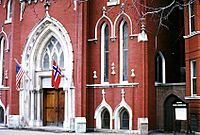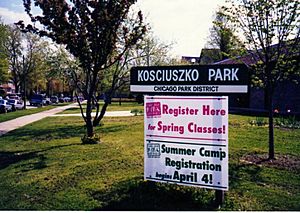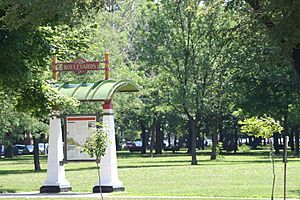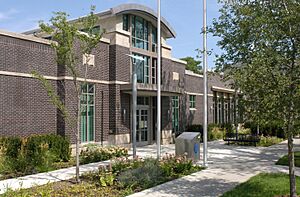Logan Square, Chicago facts for kids
Quick facts for kids
Logan Square
|
|
|---|---|
| Community Area 22 – Logan Square | |
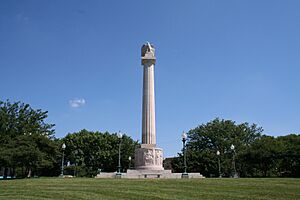
Illinois Centennial Memorial in neighborhood namesake Logan Square
|
|
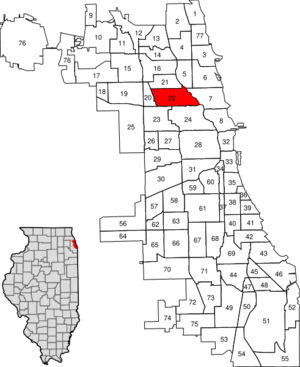
Location within the city of Chicago
|
|
| Country | United States |
| State | Illinois |
| County | Cook |
| City | Chicago |
| Neighborhoods | |
| Area | |
| • Total | 3.23 sq mi (8.37 km2) |
| Population
(2020)
|
|
| • Total | 71,665 |
| • Density | 22,176/sq mi (8,562/km2) |
| Demographics (2020) | |
| • White | 51.6% |
| • Black | 4.5% |
| • Hispanic | 36.3% |
| • Asian | 4.2% |
| • Other | 3.3% |
| Time zone | UTC−6 (CST) |
| • Summer (DST) | UTC−5 (CDT) |
| ZIP Codes |
parts of 60614, 60618, 60622, 60639, 60647
|
| Median household income (2020) | $84,653 |
| Source: Chicago Metropolitan Agency for Planning (CMAP) July 2022 Release | |
Logan Square is a cool and historic area on the northwest side of Chicago. It's one of the 77 special "community areas" in the city. The main part of Logan Square is a public square, which is like a big park. It's where three important streets meet: Milwaukee Avenue, Logan Boulevard, and Kedzie Boulevard.
This area is known for its beautiful historic streets called boulevards. You'll also see many grand "greystone" buildings and large "bungalow" style homes. Logan Square is generally bordered by the Metra railroad to the west, the North Branch of the Chicago River to the east, Diversey Parkway to the north, and the 606 (a cool elevated park) to the south.
Contents
History of Logan Square
How Logan Square Got Its Name
Logan Square is named after General John A. Logan. He was an American soldier and a political leader. The main square is a large green space. It was designed by famous architects like William Le Baron Jenney and Jens Jensen. It marks the end of Chicago's grand Boulevard System.
The Illinois Centennial Monument
In the center of the square, you'll find the Illinois Centennial Monument. It was built in 1918 to celebrate Illinois' 100th birthday as a state. The monument was designed by Henry Bacon, who also designed the Lincoln Memorial in Washington, D.C. It's a tall, 70-foot column made of "Tennessee-pink" marble. An eagle sits on top, which is a symbol of Illinois and the nation.
The monument has carvings around its base. These carvings show important parts of Illinois history. They include Native Americans, explorers, missionaries, farmers, and workers. They represent how Illinois helped the country through transportation (like railroads), education, trade, and its "pioneering spirit."
How Logan Square Grew
Logan Square started with early settlers in the 1830s. It grew from small towns like "Jefferson" and "Maplewood." In 1889, it became part of Chicago and was renamed Logan Square. Many early residents came from England and Scandinavia, especially Norway and Denmark. There were also many Polish and Jewish people.
Milwaukee Avenue is one of the oldest roads here. It was once a Native American trail. Later, it became a wooden "plank road" in 1849. In the 1890s, streetcars and the elevated train (now the Blue Line) were built along Milwaukee Avenue. This helped the area grow quickly. A baseball stadium at Milwaukee and Diversey once hosted the Logan Square Baseball Club. They even beat the Chicago Cubs and White Sox!
| Historical population | |||
|---|---|---|---|
| Census | Pop. | %± | |
| 1930 | 114,174 | — | |
| 1940 | 110,010 | −3.6% | |
| 1950 | 106,763 | −3.0% | |
| 1960 | 94,799 | −11.2% | |
| 1970 | 88,462 | −6.7% | |
| 1980 | 84,768 | −4.2% | |
| 1990 | 82,605 | −2.6% | |
| 2000 | 82,685 | 0.1% | |
| 2010 | 73,595 | −11.0% | |
| 2020 | 71,665 | −2.6% | |
Logan Square Today
Today, Logan Square is home to many different people. It has a strong Latino community, especially Mexican and Puerto Rican families. There are also people from Eastern Europe, like Poles. Many young people are moving here because of its cool vibe and beautiful boulevards. The area is part of Chicago's 26-mile boulevard system.
The "Logan Square Boulevards District" is a historic area. It was added to the National Register of Historic Places in 1985. The community works to support local parks, like the Bloomingdale Trail (an elevated park built on old train tracks). They also preserve historic buildings and support green projects.
Churches in Logan Square
Logan Square has many churches. You can find Minnekirken, the historic Norwegian Lutheran Memorial Church, right on the public square. There's also a meeting house for the Church of Jesus Christ of Latter-day Saints nearby. Other churches include Armitage Baptist Church, the Episcopal Church of the Advent, and St. John Berchmans Catholic Church.
In the Bucktown area, there are three famous "Polish Cathedrals." These are the former All Saints Cathedral, St. Hedwig's, and St. Mary of the Angels. Palmer Square is home to St. Sylvester Catholic Church and the Serbian Orthodox Church of the Holy Resurrection. Kimball Avenue Church, which used to have a 103-year-old building, now meets in Logan Square and has turned its old land into a garden.
Neighborhoods of Logan Square
Belmont Gardens
Belmont Gardens is a neighborhood that crosses both Logan Square and Avondale. It's in the northwest part of Logan Square. Its borders are generally Pulaski Road to the east, the Union Pacific/Northwest rail line to the west, Belmont Avenue to the north, and Fullerton Avenue to the south.
This area was mostly empty farmland until the 1880s. It became part of Chicago in 1889. Early development was planned by Homer Pennock, who wanted to create an industrial and residential area. While his original plan didn't fully succeed, the area quickly grew with factories and homes.
Around 1900, Belmont Gardens was part of Chicago's "Polish Corridor." This was a long area where many Polish settlers lived along Milwaukee Avenue. The neighborhood also developed many industries because it was close to the railroad. One famous spot was the Olson Park and Waterfall Complex. It was a huge garden and waterfall that many Chicagoans loved to visit.
Latino families started moving to Belmont Gardens in the 1980s. Today, it still feels like a working-class neighborhood, even as other parts of Logan Square are changing.
Bucktown
Bucktown is a neighborhood in the eastern part of Logan Square. It's north of Wicker Park. The name "Bucktown" comes from the many goats raised here in the 1800s. The original Polish name meant "Goat Prairie." Its main borders are Fullerton Avenue to the north, Western Avenue to the west, Bloomingdale or North Avenue to the south, and the Kennedy Expressway to the east.
Bucktown is mostly homes, with a mix of old houses, new modern buildings, and converted factory lofts. The Horween Leather Company has been here since 1920. The neighborhood started with Polish working-class families in the 1830s. Many Germans also moved here in the mid-1800s. In the late 1800s and early 1900s, more Polish immigrants arrived. The elevated train also helped the population grow quickly. Three beautiful "Polish Cathedrals" were built during this time: St. Hedwig's, the former Cathedral of All Saints, and St. Mary of the Angels.
Over time, street names in Bucktown changed. They went from Polish names to German names, and then to the English names we know today, like McLean and Shakespeare. After World War II, many more Polish people moved to the area. They found shops, restaurants, and banks where people spoke their language.
In the 1960s, Latino families, especially Cuban, Puerto Rican, and Mexican immigrants, began to arrive. Many Puerto Ricans moved here after housing costs rose in Lincoln Park. In recent years, many artists and young professionals have moved to Bucktown. This has led to new trendy restaurants and bars. Many older homes have been replaced with larger, modern buildings.
Bucktown has a busy shopping area on Damen Avenue. You can easily get to Bucktown using the Blue Line train. It also has many entrances to the elevated Bloomingdale Trail, also known as the 606.
Kosciuszko Park
Kosciuszko Park (pronounced "Ko-shchoosh-coe" in Polish) is a neighborhood that also spans Logan Square and Avondale. Locals sometimes call it "Koz Park" or "Land of Koz." It's a great example of how parks helped create community identity in Chicago.
The borders of Kosciuszko Park are generally Central Park Avenue to the east, Pulaski Road to the west, George Street to the north, and Altgeld to the south. This area was also part of the "Polish Corridor" along Milwaukee Avenue.
Near Kosciuszko Park is St. Hyacinth Basilica, a beautiful church built in 1894. It has special items related to Pope John Paul II. The Polish Franciscan Sisters also built a large complex here, including a nursing home. They even had a workshop where they made church clothes.
The park itself, Kosciuszko Park, was dedicated in 1916. It's named after Tadeusz Kosciuszko, a Polish hero who fought in the American Revolution. He helped design West Point. The park was one of the first parks in the Northwest Park District. It has a Tudor-style fieldhouse and a swimming pool.
The park quickly became a place for community events. People held bonfires, festivals, and even had an ice skating rink in winter. In summer, there were sports, dancing, music, and sometimes a "mobile zoo." Today, "The Land of Koz" is a diverse neighborhood. The park still brings people together for play, performances, and outdoor movies.
Logan Square (Neighborhood)
Logan Square is a neighborhood in the north-central part of the Logan Square community area. Its original borders were Kimball Avenue to the west, California Avenue to the east, Diversey Parkway to the north, and Fullerton Avenue to the south. However, the neighborhood has grown, and its eastern border is now the North Branch of the Chicago River.
This area is known for its beautiful historic boulevards and large bungalow-style homes. Logan Square once had many Norwegian-American residents, especially along the boulevards. Because housing was affordable, it was a popular place for immigrants and working-class families. The Chicago Norske Klub, a Norwegian-American cultural center, was once here. The Norwegian Lutheran Memorial Church is also located on Kedzie Boulevard.
Palmer Square
Palmer Square is a neighborhood within the Logan Square community. It's west of Bucktown and north of Humboldt Park. While its exact borders can be debated, it's generally bounded by Fullerton Avenue to the north, Armitage Avenue to the south, Kedzie Boulevard to the west, and Milwaukee Avenue to the east.
The neighborhood gets its name from the 7.68-acre Palmer Square Park. The park is named after John McAuley Palmer. He was a lawyer and Civil War General. He also served as the Governor of Illinois and a U.S. Senator. He was a strong opponent of slavery and a friend of Abraham Lincoln.
In the late 1800s, when bicycles became popular, the Palmer Place oval in the park was a favorite spot for "wheelmen" to ride. Ignaz Schwinn, who started the Schwinn Bicycle Company, lived nearby.
In 2005, the city received a grant to improve Palmer Square Park. After getting ideas from the community, the Chicago Park District finished building the park in 2009. It now has a children's play area, walking trails, and open lawns. In the summer of 2021, live music performances were held in the park every Sunday.
Palmer Square is a great place to live because it's close to many shops, coffee houses, bars, and restaurants. It's also easy to get to highways and public transportation. This makes it popular for people who work downtown or go to colleges like DePaul University. The neighborhood is served by the Blue Line train and several CTA bus routes.
Public Libraries
The Chicago Public Library has one branch in the Logan Square area. It's called the Logan Square Branch and is located at 3030 W. Fullerton.
Cultural Organizations
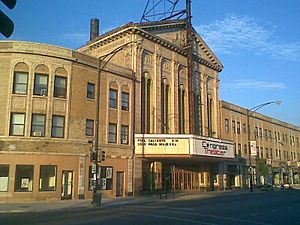
Logan Square has many different cultural places. The Comfort Station is an art gallery and event space. AnySquared Projects is a non-profit art group. St. Hedwig's in Chicago is an important cultural center for the Catholic community. The Hairpin Arts Center is managed by the Logan Square Chamber of Arts.
The Lincoln Lodge on Milwaukee Avenue offers live comedy shows most nights. Next door is the office of In These Times, a magazine focused on social justice. Media groups like Community TV Network (a youth media organization) and the Chicago Independent Media Center are also in Logan Square. Local news blogs like LoganSquarist cover the neighborhood.
The historic Congress Theater is being redeveloped. The plan includes the 4,900-seat theater, a hotel, restaurants, and apartments. This big project will cost about $70.4 million.
Education
Students in Logan Square attend Chicago Public Schools.
The Roman Catholic Archdiocese of Chicago also runs several schools in the area. These include Our Lady of Grace School, St. John Berchmans School, and St. Sylvester School.
Notable People
Many interesting people have lived in Logan Square:
- Jessica Camacho (born 1982), an actress from TV shows like The Flash and Watchmen, grew up here.
- Morris Childs (1902–1991), a double agent for the F.B.I. against the Soviet Union, lived here as a child.
- Eve Ewing (born 1986), a sociologist, author, and poet, grew up in Logan Square.
- John Guzlowski (born 1948), a Polish-American author and poet, was a childhood resident.
- Lori Lightfoot (born 1962), the 56th Mayor of Chicago (2019–2023), lives in Logan Square.
- Adam Lizakowski (born 1956), a Polish poet and translator, used to live here.
- Richard Nickel (1928–1972), a photographer and preservationist, grew up in the neighborhood.
- Knute Rockne (1888–1931), a famous football coach, lived here as a child.
- William A. Redmond (1908–1992), who was the Speaker of the Illinois House of Representatives, grew up in Logan Square.
- Mike Royko (1932–1997), a Pulitzer Prize-winning newspaper columnist, was a childhood resident.
- Ignaz Schwinn (1860–1948), who founded the Schwinn Bicycle Company, lived in Palmer Square.
- Shel Silverstein (1930–1999), a famous author and poet, grew up in Logan Square.



